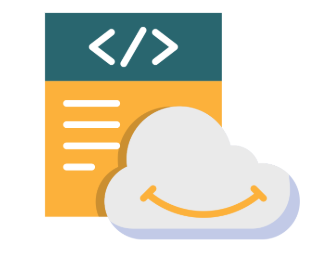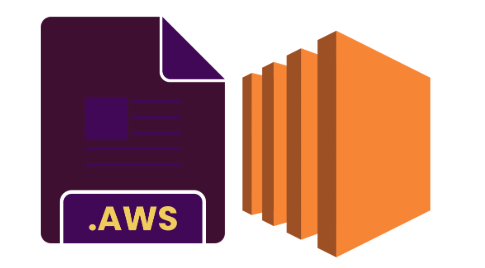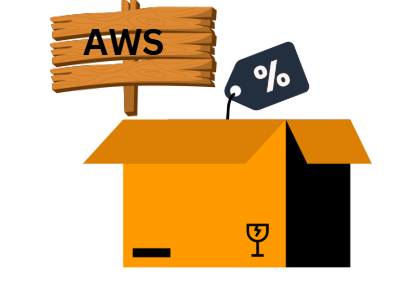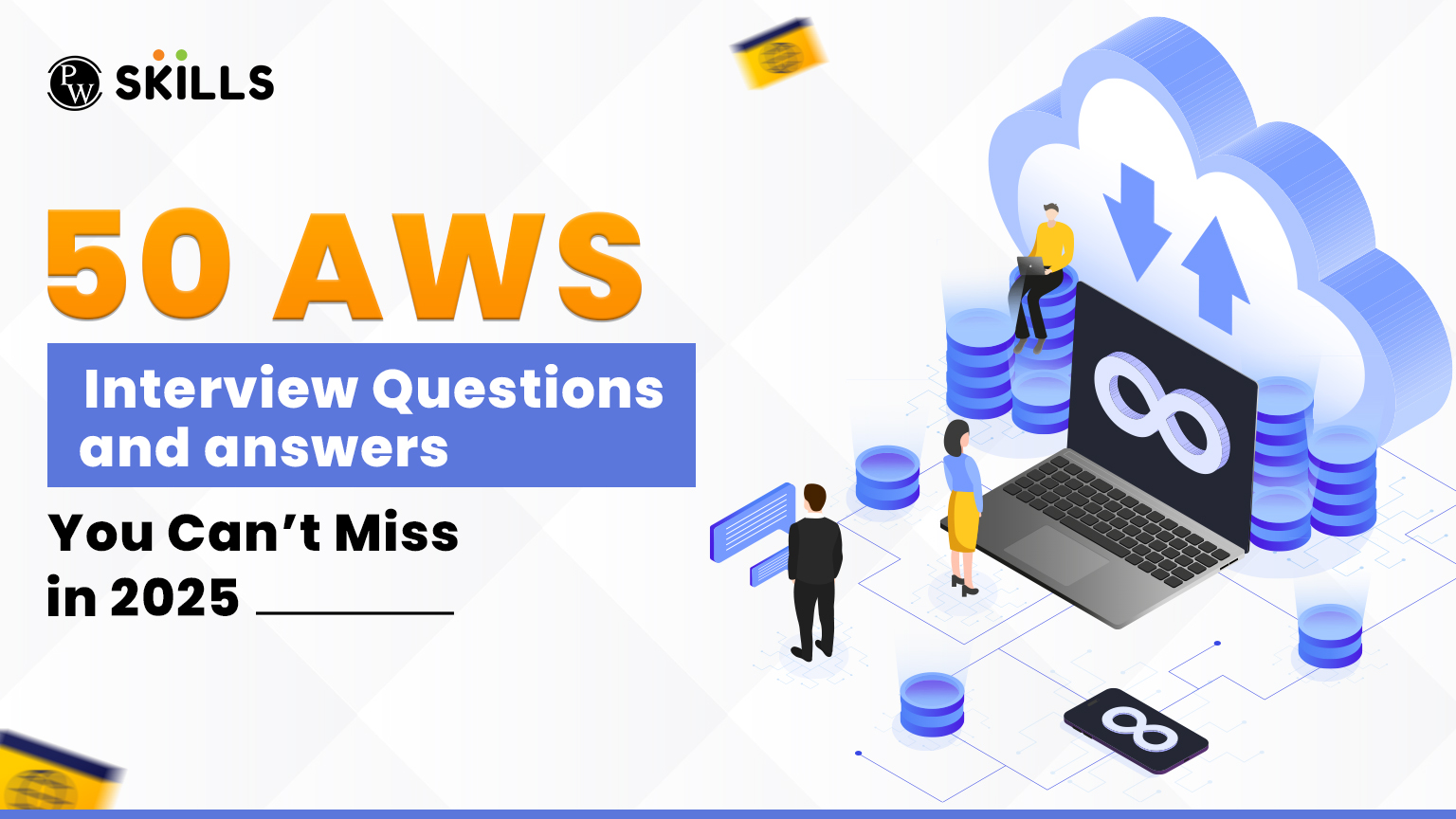AWS Interview questions and answers are articles providing you with knowledge of fundamentals and advanced concepts around AWS. Prepare for your AWS Exam journey with PW Skills. Amazon Web Services (AWS) continues to dominate the cloud computing industry, and mastering AWS is a must for IT professionals looking to stay ahead in 2025.

Whether you are preparing for a cloud engineer, solutions architect, or DevOps role, having a solid grasp of AWS fundamentals is crucial. In this article, we have compiled the 50 most commonly asked AWS interview questions and answers to help you land your dream job.
AWS Basic Interview Questions For Beginners
As a beginner, you need to start with some basic questions related to AWS and its features. Let us get an overview of some fundamentals of AWS with AWS interview questions and answers.
Q1. What is AWS?
Ans. AWS stands for Amazon Web Services. It is a cloud computing platform provided by Amazon that offers a wide range of services such as computing power, storage, databases, machine learning, and security solutions.
Q2. What are the key benefits of AWS?
Ans. Some of the major benefits of AWS are mentioned below:
- Scalability
- Cost-effectiveness (pay-as-you-go model)
- Security and compliance
- High availability and fault tolerance
- Flexibility with various services
Q3. What is EC2 in AWS?
Ans. EC2 stands for Elastic Compute Cloud. It is a web service that provides resizable computing capacity in the cloud, allowing users to launch virtual servers as needed.
Q4. What is an S3 bucket in AWS?
Ans. Amazon S3 stands for Simple Storage Service. It is an object storage service that allows users to store and retrieve any amount of data at any time.
Q5. Explain the difference between AWS Regions and Availability Zones.
Ans. AWS Regions are separate geographical locations, while Availability Zones are isolated locations within a region that provide redundancy and failover capabilities.
AWS Interview Questions And Answers

If you are an experienced professional with some knowledge of AWS then try attempting these AWS interview questions and answers given below and strengthen your knowledge a little bit more.
Q6. What are the different types of EC2 instances?
Ans. EC2 instances come in various types such as:
- General Purpose (e.g., T3, M5)
- Compute Optimized (e.g., C5)
- Memory Optimized (e.g., R5, X1)
- Storage Optimized (e.g., I3, D2)
- Accelerated Computing (e.g., P3, G4)
Q7. What is AWS Lambda?
Ans. AWS Lambda is a serverless computing service that runs code in response to events without provisioning or managing servers.
Q8. What is Auto Scaling in AWS?
Ans. Auto Scaling automatically adjusts the number of EC2 instances based on demand to maintain performance while minimizing costs.
Q9. What is the difference between ECS and EKS?
Ans. The differences between ECS and EKS are mentioned below:
- ECS (Elastic Container Service): AWS-managed service for running Docker containers
- EKS (Elastic Kubernetes Service): AWS-managed service for running Kubernetes workloads.
Q10. What is AWS Lightsail?
Ans. AWS Lightsail is a simplified cloud platform that provides developers with easy-to-use virtual servers, databases, and networking.
AWS Storage and Database Interview Questions

Let us get some of the AWS Interview questions and answers below for storage and databases in the system.
Q11. What are the different types of storage available in AWS?
Ans. The different types of storage that are available in AWS are mentioned below:
- Amazon S3 (Object Storage)
- Amazon EBS (Block storage for EC2)
- Amazon EPS (File Storage)
- Amazon Glacier (Cold Storage for Archival)
Q12. What is the difference between Amazon RDS and DynamoDB?
Ans. To know the difference between Amazon RDS and DynamoDB, let us first know what are they exactly:
- RDS: Managed relational database service (SQL-based, e.g., MYSQL, PostgreSQL, Oracle))
- DynamoDB: Fully Managed NoSQL database for key-value storage.
Q13. What is AWS Redshift?
Ans. Redshift is a fully managed data warehouse solution that allows businesses to analyze large datasets efficiently.
Q14. What is Amazon Aurora?
Ans. Amazon Aurora is a fully managed relational database engine compatible with MySQL and PostgreSQL, providing enhanced performance and scalability.
Q15. What is an IAM role in AWS?
Ans. IAM stands for Identity and Access Management. IAM roles provide temporary access permissions to AWS services without using long-term credentials.
AWS Security and Networking Interview Questions

Some of the AWS interview questions and answers based on networking and security are given below for your practice and preparation.
Q16. What is an AWS VPC?
Ans. Amazon VPC, where VPC stands for Virtual Private Cloud, allows users to create isolated networks within AWS to enhance security and control.
Q17. What is an AWS Security Group?
Ans. AWS Security Groups act as virtual firewalls, controlling inbound and outbound traffic to EC2 instances.
Q18. What is the difference between an AWS Security Group and an NACL?
Ans. The AWS Security Group controls traffic at the instance level, whereas the NACL (Network ACL) controls traffic at the subnet level.
Q19. What is AWS Shield?
Ans. AWS Shield is a managed DDoS protection service that safeguards AWS applications against cyber threats.
Q20. What is AWS WAF?
Ans. WAF stands for Web Application Firewall. It protects applications from common web exploits by filtering incoming traffic.
AWS DevOps and Monitoring Interview Questions

Check some of the AWS Interview questions and answers based on DevOps and cloud computing monitoring and more. Practice these questions along with the fundamentals to stay prepared for your interview journey.
Q21. What is AWS CloudFormation?
Ans. AWS CloudFormation enables infrastructure as Code (IaC) by allowing users to define cloud resources using templates.
Q22. What is AWS CloudWatch?
Ans. AWS CloudWatch is a monitoring service for AWS applications, providing insights into resource utilization and performance metrics.
Q23. What is AWS CodePipeline?
Ans. AWS CodePipeline automates the software release process, integrating with CI/CD tools.
Q24. What is AWS Elastic Beanstalk?
Ans. AWS Elastic Beanstalk is a platform-as-a-service (PaaS) solution for deploying applications without managing infrastructure.
Q25. What are AWS Step Functions?
Ans. AWS Step Functions is a serverless orchestration service that automates workflows using workflow automation.
AWS Advanced Questions for Experienced Professionals

If you are an industry professional you must have a deeper understanding of these AWS Interview questions and answers to succeed in interview rounds.
Q26. How does AWS handle high availability?
Ans. AWS uses multi-AZ deployments, load balancing, and auto-scaling to ensure high availability and fault tolerance.
Q27. How do you optimize AWS costs?
Ans. We can optimize AWS costs by different methods, including:
- Use Reserved Instances or Spot Instances
- Implement auto-scaling
- Use AWS Cost Explorer for monitoring
- Enable S3 lifecycle policies
Q28. What is AWS Glue?
Ans. AWS Glue is a serverless data integration service for ETL (Extract, Transform, Load) processes.
Q29. What is AWS Data Pipeline?
Ans. AWS Data Pipeline automates the movement and transformation of data across AWS services.
Q30. What is AWS Kinesis?
Ans. AWS Kinesis is a real-time data streaming service for processing large amounts of data from different sources.
Miscellaneous AWS Interview Questions and Answers
Prepare these additional AWS interview questions and answers suitable for all beginners and advanced professionals.
31. How do you ensure high availability in AWS?
Ans. High availability in AWS can be achieved using:
- Multi-AZ deployments (e.g., RDS, EC2).
- Auto Scaling and Load Balancers.
- S3 cross-region replication.
- CloudFront for global content distribution.
- Route 53 failover routing.
32. What are AWS Organizations and SCPs?
Ans. AWS Organizations allows centralized management of multiple AWS accounts. Service Control Policies (SCPs) restrict permissions for AWS accounts within an organization.
33. What is AWS CloudFormation, and how does it work?
Ans. CloudFormation is an Infrastructure as Code (IaC) service that enables automated provisioning of AWS resources using YAML or JSON templates. It helps manage infrastructure as reusable and versioned code.
34. What are Amazon EKS and ECS?
Ans. Let us take a short overview of Amazon EKS and ECS in AWS system platforms.
- Amazon ECS (Elastic Container Service): AWS-managed container orchestration service for running Docker containers.
- Amazon EKS (Elastic Kubernetes Service): A managed Kubernetes service for deploying and managing containerized applications.
35. What is AWS Security Hub?
Ans. AWS Security Hub provides a unified security posture by aggregating security alerts from various AWS services like GuardDuty, Inspector, and IAM Access Analyzer.
36. What are AWS Step Functions?
Ans. AWS Step Functions allow developers to coordinate multiple AWS services into serverless workflows, automating processes like ETL, data processing, and machine learning pipelines.
37. How do you secure data in AWS?
Ans. Some of the security best practices include:
- Encryption: Using AWS KMS for encrypting S3, EBS, and RDS.
- IAM Policies: Implementing least privilege access control.
- Security Groups & NACLs: Restricting access at network levels.
- AWS Shield & WAF: Protecting against DDoS attacks.
38. What is AWS Direct Connect, and how does it work?
Ans. AWS Direct Connect provides a dedicated network connection between AWS and on-premises data centers. It improves network performance, security, and reliability for hybrid cloud deployments.
39. How do you optimize AWS costs?
- Use Reserved Instances (RIs) or Savings Plans for predictable workloads.
- Enable Auto Scaling to match capacity with demand.
- Use Spot Instances for flexible, non-critical workloads.
- Monitor usage with AWS Cost Explorer and Budgets.
- Use S3 Lifecycle Policies for storage optimization.
40. What is AWS Control Tower?
Ans. AWS Control Tower provides an automated way to set up and govern multi-account AWS environments using pre-configured best practices. It simplifies compliance, security, and governance at scale.
Professional Level AWS Questions
Some of the professional level AWS Interview questions and answers are mentioned below for your reference.
41. What are the different types of cloud computing models in AWS?
Ans. AWS provides three main cloud computing models:
- Infrastructure as a Service (IaaS): Provides virtualized computing resources over the internet (e.g., Amazon EC2).
- Platform as a Service (PaaS): Offers a platform allowing developers to build applications (e.g., AWS Elastic Beanstalk).
- Software as a Service (SaaS): Delivers software applications over the internet (e.g., Amazon WorkSpaces).
42. What is an Amazon EC2 instance, and what are its types?
Ans. Amazon Elastic Compute Cloud (EC2) provides resizable computing capacity in the cloud. The instance types include:
- General Purpose (e.g., t3, m5) – Balanced computing, memory, and networking.
- Compute Optimized (e.g., c5, c6g) – Best for compute-heavy applications.
- Memory Optimized (e.g., r5, x1) – Best for in-memory workloads.
- Storage Optimized (e.g., i3, d2) – Best for high-speed storage requirements.
43. What are the different types of storage services in AWS?
- Amazon S3: Object storage for data backups and archiving.
- Amazon EBS: Block storage for EC2 instances.
- Amazon EFS: Scalable file storage for Linux-based workloads.
- Amazon Glacier: Low-cost archival storage.
44. How does AWS Auto Scaling work?
Ans. AWS Auto Scaling automatically adjusts compute resources to maintain performance and minimize costs. It uses:
- Dynamic Scaling: Adjusts capacity based on traffic patterns.
- Predictive Scaling: Uses ML models to forecast demand and scale resources accordingly.
45. What are the different types of load balancers in AWS?
Ans. AWS provides three types of load balancers in Elastic Load Balancing (ELB):
- Application Load Balancer (ALB): Works at Layer 7, suitable for HTTP/HTTPS traffic.
- Network Load Balancer (NLB): Works at Layer 4, suitable for high-performance TCP/UDP traffic.
- Classic Load Balancer (CLB): Supports both Layer 4 and 7 but is older.
46. What is an AWS VPC, and what are its components?
Ans. A Virtual Private Cloud (VPC) is a logically isolated network in AWS. Key components include:
- Subnets (Public and Private)
- Internet Gateway (IGW)
- NAT Gateway
- Security Groups & Network ACLs
- Route Tables
47. What is IAM, and what are its components?
Ans. Identity and Access Management (IAM) allows you to manage access permissions securely. Components include:
- Users: Individual AWS accounts.
- Groups: Collection of users with shared permissions.
- Roles: Used to assign temporary permissions to AWS resources.
- Policies: JSON-based rules defining permissions.
48. What is AWS Lambda, and how is it used?
Ans. AWS Lambda is a serverless computing service that runs code in response to events without provisioning servers. It supports:
- Event-driven triggers (e.g., S3 file upload, DynamoDB changes).
- Scalability on demand.
- Support for multiple programming languages like Python, Node.js, and Java.
49. How does AWS Route 53 work?
Ans. Route 53 is a scalable Domain Name System (DNS) web service that manages domain names. Features include:
- DNS Routing (e.g., simple, weighted, latency-based, failover).
- Domain registration.
- Health checks and traffic flow policies.
50. What is Amazon RDS, and how does it differ from DynamoDB?
- Amazon RDS (Relational Database Service) is a managed relational database supporting MySQL, PostgreSQL, SQL Server, etc.
- DynamoDB is a NoSQL database offering key-value and document-based storage.
- RDS is used for structured data with complex relationships, whereas DynamoDB is ideal for high-scale applications requiring low-latency performance.
Learn DevOps and Cloud Computing with PW Skills
Prepare for your interviews with a complete DevOps and Cloud Computing Course with in-depth tutorials, hands-on practical training, and exercises to prepare you for your AWS journey. Prepare for any AWS based certification exam with this interactive course on PW Skills and get access to industry led live sessions, recorded lectures, and module assignments prepared by dedicated mentors at PW Skills.
AWS Interview Questions And Answers FAQs
Q1. What topics are covered in the AWS job interview guide?
Ans. The major topics that are covered in the AWS job interview guide include EC2, S3, VPC, Lambda, RDS, CloudFormation, and more providing detailed explanations to assist in completing the AWS job interview.
Q2. How many AWS Interview questions and answers are in this article?
Ans: In this article, the number of Amazon interview questions and answers is 50, which comprises basic, intermediate, and professional-level questions for practice.
Q3. What is the full form of AWS?
Ans: AWS Stands for Amazon Web Services, which provides a platform for scalable applications and networking by Amazon.
Q4. How to secure data in AWS?
Ans: Data can be secured in AWS using encryption, IAM policies, security groups, and WAF against any unauthorized access, data theft, and vulnerabilities.

